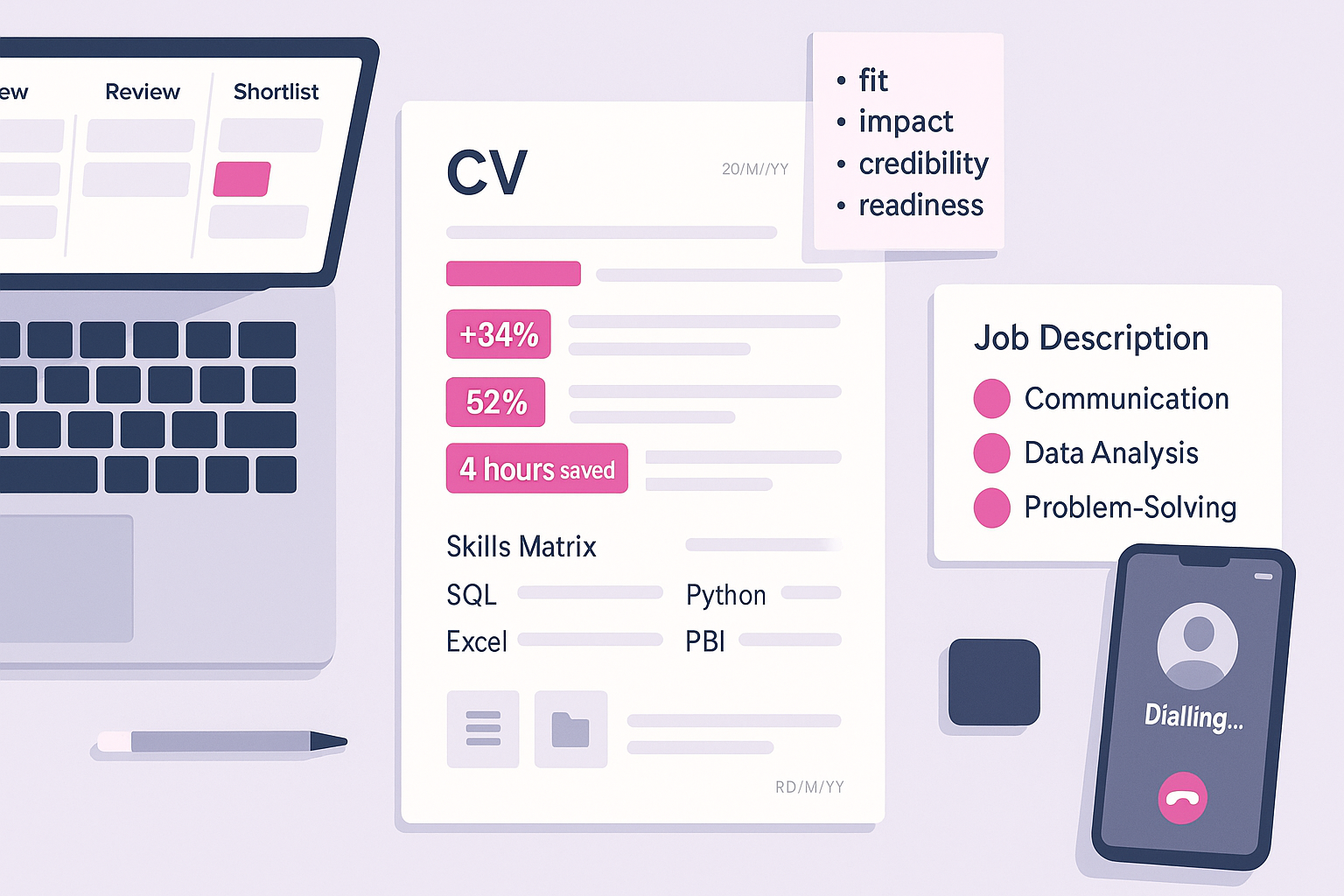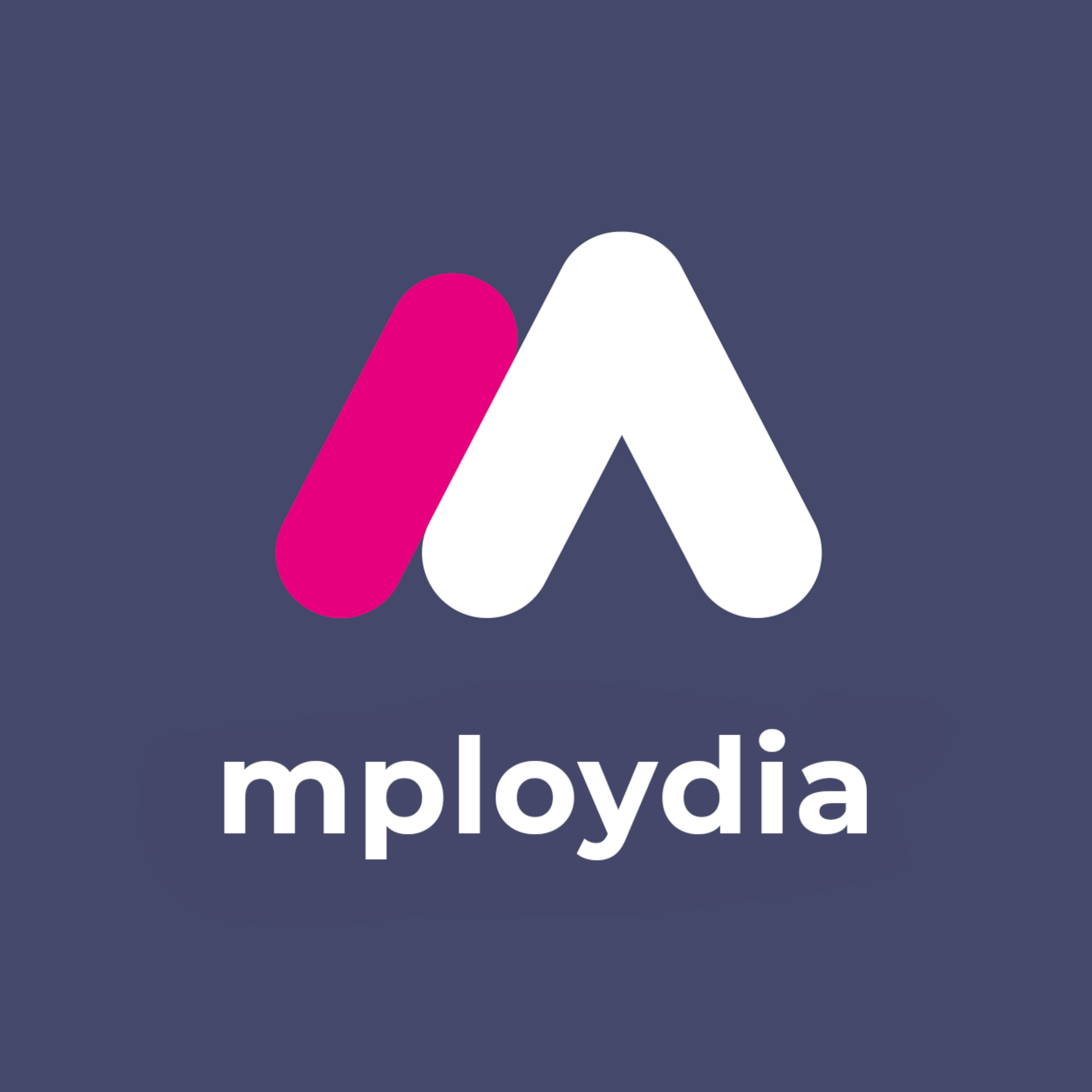
CV Wins That Get Calls: Practical Moves Recruiters Notice
What a “call-trigger” CV actually signals
If your CV is not getting calls, it is not doing its job. Recruiters skim, score, then shortlist in minutes. You have a small window to prove you fit, deliver outcomes, and will be worth a conversation now. This article gives you specific moves that turn dead applications into phone calls. Not fluff. Tactics you can apply today.
What counts as a CV win? Anything that quickly signals fit, impact, credibility, and readiness. Stack enough of these up the page and you earn the call. Miss them and you are invisible, even if you are capable.
Here is exactly how to build a CV that gets calls.
- Fit: You match the job’s core requirements and language.
- Impact: You deliver measurable outcomes, not activity.
- Credibility: Proof points that reduce perceived risk.
- Readiness: You can start, adapt, and add value quickly.
If your CV does not make these four signals obvious within the first 10 seconds, you lose. Everything below is engineered to achieve those signals fast.
Build a top fold that earns a call
Your top third decides your fate. Design it to answer “Why call you?” in one glance.
- Name + role target: “Samir Patel | Graduate Data Analyst”
- Location + right to work: “Manchester | Right to work in the UK”
- Contact: Mobile, professional email, LinkedIn URL
- Profile summary: Two sentences. Who you are, what you deliver, one credibility signal, what you want next.
- Impact highlights bar: Three quantified results aligned to the job.
- Skills matrix mapped to the spec: 6 to 10 hard skills the advert demands, not generic buzzwords.
- Portfolio or proof links: GitHub, Behance, personal site, case studies, or a single “Project highlights” doc.
Profile summary formula
- Sentence 1: Identity + capability + focus area
“STEM graduate skilled in SQL and Python, focused on turning messy data into clear decisions.” - Sentence 2: Proof + outcome + target role
“Delivered a 28 percent processing time reduction on a capstone project; now seeking a Data Analyst role where I can ship measurable improvements from week one.”
Impact highlights bar examples
- Cut onboarding time 34 percent by redesigning a Notion workspace used by 40 users
- Increased student society event attendance 52 percent through targeted social posts
- Deployed a Power BI dashboard that removed 4 hours weekly manual reporting
Skills matrix mapped to job ads
Replace generic lists like “communication, teamwork” with job-specific hard skills.
- Do: SQL, Excel advanced, Power BI, DAX, A/B testing, GA4, HubSpot, Python, Figma, HTML/CSS, Jira
- Don’t: Team player, problem-solver, dynamic, fast learner (prove these with examples instead)
Write bullets that win calls, not yawn scrolls
Use the PAR method: Problem, Action, Result. Lead with outcomes. Numbers first. Keep to one line where possible.
- Bad: Responsible for social media posts and weekly reports
- Good: Grew Instagram reach 73 percent in 8 weeks by testing a 3-post cadence and optimising captions to keywords
- Bad: Helped with customer service tasks
- Good: Resolved 42 tickets per day at 93 percent CSAT by using a new tag workflow and saved the team 5 hours weekly
Power verbs that signal capability
- Built, led, automated, reduced, increased, shipped, improved, migrated, launched, optimised, consolidated, negotiated, accelerated, validated
Context, scale, complexity
Always add scope to show weight.
- “Managed 12 stakeholder interviews across 3 departments to map requirements for a new intake process.”
- “Handled £8k event budget and delivered 9 percent under target without cutting core activities.”
Map your CV to the job spec step by step
Stop guessing. Engineer the match.
- Extract keywords: Paste the job description into a word cloud. Identify repeated nouns, tools, and outcomes.
- Prioritise must-haves: Highlight 6 to 10 essentials that appear multiple times.
- Mirror language: Use the employer’s terminology and synonyms. If they say “stakeholder management,” use it. If they say “client-facing,” reflect it.
- Place for impact: Put the top 3 keywords in your profile, skills matrix, and the first bullet under each role or project.
- Prove with evidence: Give one quantified example per essential keyword.
- Remove non-matching clutter: If it does not serve this job, cut or compress it.
- Validate with a skim test: Can a stranger see you match the spec in 12 seconds?
ATS-friendly layout that still looks clean
Applicant tracking systems read left to right, top to bottom. Keep structure simple.
- Format: One page for graduates and early career. Two pages only if you have substantial relevant experience.
- File: PDF for humans, DOCX if the portal explicitly requires it.
- Fonts: System-safe fonts like Calibri, Arial, or Verdana at 10 to 11.5 pt.
- Headings: Experience, Education, Projects, Skills, Certifications.
- No tables for core content. Two-column designs confuse some ATS.
- Use standard section labels. Avoid text in images or graphics for crucial info.
- File naming: Firstname_Lastname_CV_TargetRole_Company.pdf
- Avoid headers and footers for essential data. Some ATS ignore them.
UK CV conventions that protect you
- Do not include a photo, date of birth, marital status, NI number, or full address.
- City and postcode are enough. Add “Right to work in the UK” if relevant.
- “References available on request” is unnecessary. Use the space for impact.
- Add predicted degree classification if you are a final-year student.
- Include A levels and selected GCSEs only if you lack other experience or the employer requests them.
Education and projects that earn calls without experience
No experience is not an excuse. Provide proofs.
What to include
- Capstone projects with stakeholder context, tools, and quantified outcomes
- Hackathons, case competitions, voluntary projects, society leadership roles
- Micro-internships, virtual experience programmes, freelance gigs
- Course projects with real data, user tests, or real users
How to present a project
- Title: “Operations Optimisation Project, University of Leeds”
- Context: Who for, what problem, constraints
- Tools: Excel VBA, Power BI, SQL
- Actions: 3 bullets using PAR
- Results: One bullet with numbers and a link to a repo or deck
Example
- Reduced order picking time 22 percent by redesigning shelf labelling and creating a picker route matrix tested over 3 shifts. Built a Power BI dashboard that flagged SKUs with the highest travel cost.
Credibility signals that de-risk you
- Certifications: Google Analytics, HubSpot, AWS Cloud Practitioner, Microsoft Azure Fundamentals, LinkedIn Learning badges. Only include relevant ones.
- Portfolio proof: Links to GitHub, Behance, Dribbble, Notion case studies, Tableau Public.
- Recommendations: 2 to 3 strong LinkedIn recommendations pinned near the top.
- Awards: Scholarships, competition wins, employer commendations.
- Thought pieces: One or two short articles on LinkedIn about your area of interest.
- Social proof: Star ratings, CSAT, Trustpilot quotes from volunteer work if relevant.
Numbers that make recruiters call by function
Sales and business development
- “Generated 38 qualified leads and 5 closed deals in 8 weeks by building a 3-touch outreach sequence using LinkedIn and email.”
- “Hit 128 percent of monthly SDR target for 3 consecutive months; booked 41 meetings.”
Marketing and growth
- “Increased email open rate from 18 percent to 34 percent by A/B testing subject lines and send times; grew CTR by 61 percent.”
- “Delivered 9.2k organic visits in 90 days through keyword clustering and updating 12 landing pages.”
Customer success and support
- “Handled 420 tickets in first month at 92 percent CSAT and 1.8-hour median resolution.”
- “Reduced churn risk for 7 accounts by building ‘first 30 days’ onboarding playbooks.”
Operations and admin
- “Cut invoice processing time from 3 days to 6 hours by creating a naming convention and Excel macro.”
- “Improved stock accuracy from 88 percent to 97 percent through weekly cycle counts and a variance dashboard.”
Data and analytics
- “Automated weekly KPI pack with SQL and Power BI, saving 4 hours per week and increasing accuracy to 99 percent.”
- “Built a model to forecast demand with a 12 percent MAPE improvement using Python and Prophet.”
Product and design
- “Ran 12 user tests to improve onboarding; reduced time to first success by 41 percent.”
- “Shipped a Figma prototype that increased sign-up rate from 2.1 percent to 3.6 percent.”
Engineering and IT
- “Deployed a Flask app to Azure with CI/CD; cut manual release time from 30 minutes to 4.”
- “Resolved 56 percent of tickets at first contact by building a knowledge base and standard operating procedures.”
Finance and accounting
- “Reconciled 3 years of transactions; reduced aged debtors by 18 percent in 6 weeks.”
- “Delivered a month-end pack 1.5 days faster by streamlining journals and a fixed asset template.”
Human resources and talent
- “Sourced 120 candidates and filled 9 roles in 10 weeks by building Boolean searches and a structured screening rubric.”
- “Improved new hire time to productivity by 30 percent with a checklisted onboarding plan.”
Language that gets calls
Short, measurable, and clear beats clever. Use employer language. Avoid vague claims.
- Replace “Strong communication skills” with “Presented findings to 10 stakeholders; recommendations adopted.”
- Replace “Team player” with “Co-led 4-person team; delivered on time and 6 percent under budget.”
- Replace “Hard-working” with a number that proves it: output, response time, deliverables shipped.
Formatting that accelerates skim speed
- Use 0.9 to 1.15 line spacing. Keep margins at 1.6 to 2.0 cm for readability.
- Use bold to highlight results, not job titles only.
- Keep bullets to one or two lines. Two to five bullets per experience entry.
- Order experiences by relevance, not only by time. Create a “Selected Projects” section above older part-time roles if more relevant.
Tidy up job titles without lying
Match market language while staying accurate.
- You did “Operations Assistant” work but the contract says “Volunteer.” Use “Operations Assistant (Volunteer).”
- Your title was “Assistant,” but your work matched “Junior Analyst.” Use “Assistant Analyst.”
The 12-second skim test
Give your CV to someone unfamiliar with your background. Let them scan for 12 seconds. Ask them three questions:
- What role do you think I want?
- What three strengths or tools stood out?
- What results prove I can do it?
If they cannot answer, you have not earned a call. Fix the top fold.
Before and after: from duties to outcomes
Before
- Responsible for onboarding new members to the society
- Helped manage email newsletter and attendance tracking
After
- Onboarded 84 new members in 6 weeks with a checklist and welcome series, increasing event attendance by 52 percent
- Built a segmentation and content calendar that doubled newsletter CTR from 2.4 percent to 4.9 percent
The new bullets earn calls because they show scale, method, and measurable result.
Common myths to ignore
- Myth: “Two pages looks more experienced.” Reality: Two pages of filler kills momentum. One high-impact page beats two weak ones.
- Myth: “CVs must be creative to stand out.” Reality: Clarity wins. Keep it clean, not gimmicky.
- Myth: “Include everything you have done.” Reality: Relevance wins. Curate.
- Myth: “ATS decides everything.” Reality: Humans call. Pass ATS, then impress a human fast.
The graduate advantage: show trajectory
Hiring managers love steep learning curves. Prove you learn fast.
- Show certifications with dates in the past 6 months
- Demonstrate progression across projects or roles
- Present before and after improvements you delivered within short time frames
- Quantify speed to impact: “Delivered first dashboard in week two”
Smart extras that nudge people to call
- Availability: “Available to start in 2 weeks” or “Immediate” if true
- Travel and flexibility: “Open to travel within the UK” if required
- Languages: List only if useful for the role
- Security clearance or DBS if relevant
Quality control checklist
- Spelling and grammar: British English only. No typos. Read aloud.
- Consistency: Same date formats, punctuation, hyphenation, and tense.
- Active voice: No “responsible for.” Use action verbs.
- Links: Test every link. Use short, readable URLs.
- PDF export: Check layout. Ensure text is selectable.
Follow-up that multiplies calls
Apply, then follow up with a short message to the hiring manager or recruiter.
Subject: Application for Graduate Analyst – Samir Patel
Hi [Name], I applied for the Graduate Analyst role today. In my last project I cut reporting time by 4 hours a week by automating the KPI pack in Power BI. I would welcome a short call to discuss how I can ship similar wins in month one. CV and portfolio here: [link]. Thanks, Samir
Short, specific, and relevant. This email wins calls because it shows fit and outcome in two lines.
15 CV wins that get calls now
- A role-aligned headline in the first line
- A two-sentence profile with one proof point
- Three quantified impact highlights near the top
- A skills matrix that mirrors the job advert
- A link to a relevant portfolio or case study
- Outcome-led bullets using PAR
- Numbers that show scale, speed, and savings
- Clean ATS-safe layout and sensible file name
- UK-ready essentials: location, right to work, no photo
- Projects presented like real work with context and results
- Credibility signals: certifications, awards, recommendations
- Language that matches the employer’s terms
- A 12-second skim test passed by a stranger
- Availability and practical details that remove friction
- A short, specific follow-up email after applying
Quick templates you can copy
Profile
“Business graduate focused on operations efficiency. Reduced order processing time 22 percent in a capstone project by redesigning workflows and dashboards. Seeking an Operations Analyst role where I can ship measurable improvements from week one.”
Bullet formula
[Action verb] + [what you did] + [tool or method] + [result with number] + [scope or time]
Example
“Automated invoice matching using Excel VBA, cutting processing time from 3 days to 6 hours across 120 monthly invoices.”
Skills matrix example
SQL | Excel advanced | Power BI | Python basics | A/B testing | GA4 | HubSpot | Figma | Jira | HTML/CSS
Final word
CV wins that get calls are not magical. They are engineered. Align to the spec, front-load proof, write outcomes not duties, and show credible signals. If a hiring manager can see you will deliver value in the first month, you get the call. Build that case on page one and make it impossible to ignore.
Next Steps
Want to learn more? Check out these articles:
Adopt a Hiring Manager First Mindset to Get Hired Faster
Graduate credibility signals UK: fast ways to prove you fit
Job Search Sprints: Build Momentum and Get Hired Faster Now
Check out our Advanced Employability Course for all the help you need to get your dream job, fast.


